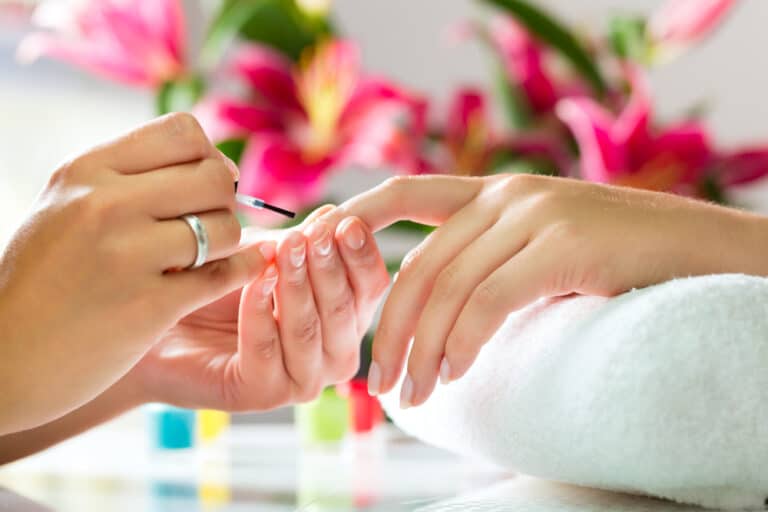Why Does My Makeup Look Dry? (Reasons, Fixes)

Those who wear makeup understand the time and energy the application takes.
Many steps are involved that require patience and a steady hand.
Doing makeup adds time to our routine and must be factored into our schedules, so when it comes out looking dry or any less than perfect, it’s easy to get frustrated.
Everyone has a different skin type, uses different products, lives in different climates, and has different lifestyles—all elements that influence how your makeup looks.
There are many reasons why your makeup may look dry, but fortunately, many causes have simple solutions.
Why Does My Makeup Look Dry? (Reasons, Fixes)
1. You Didn’t Moisturize Before Applying Your Makeup

Hydration is key when it comes to your face, whether you apply makeup or not.
Some makeup products tend to dry out your skin, giving you a cakey and dry look.
However, if you moisturize properly before applying your foundation or base makeup, there’s less chance your makeup will look dry.
It’s important to wash or cleanse your face every morning or before applying makeup.
This ensures your skin is free of excess oils, pollutants, and dirt—things that can clog your pores and make it difficult for your moisturizer to be effective.
If your skin is naturally on the dry side, using a gentle cleanser with moisturizing ingredients infused into it will help create the hydrating groundwork for your makeup routine.
Once you cleanse your face, apply a good all-day moisturizer—preferably with SPF.
Look for moisturizers with hydrating ingredients like hyaluronic acid, squalene, ceramides, botanical oils, antioxidants, vitamin B5, shea butter, or peptides.
These ingredients work to keep your skin hydrated throughout the day and also provide a skin barrier, protecting your face from drying outdoor air and other harmful environmental effects.
Even if you have naturally oily skin, it’s crucial to moisturize before applying makeup.
Oil is not the same as hydration and when you go without a moisturizer, you’re actually forcing your skin to create more oil to make up for the lack of moisture.
Dermatologist Doris Day says, “Increased hydration supports a stronger barrier…which then helps curb oil production.”
2. You’re Using the Wrong Products For Your Skin Type

Your skin type has much to do with the makeup products you should use on it to achieve an even and moisturized glow.
For those with dry skin, it’s beneficial to look for makeup products targeted to those with normal to dry skin.
Those products typically have more hydrating ingredients and come in liquid or cream bases that are lightweight and easy to apply.
Using a tinted moisturizer and applying concealer as a spot treatment instead of using heavy foundation will help keep your face free of unnecessary dryness.
When it comes to foundations, to avoid dry-looking makeup, it’s vital to steer clear of silicone or matte-finish products, as these tend to attach to dry spots and highlight them even more.
Water-based foundations are best when working with dry skin.
Stay away from powder foundations, as they will most likely make your face look dry and cakey.
Using the right setting powder for dry skin is also tricky, but if you still want to use powder, be sure to use a lightweight formula and gently brush it over your face or on target areas that need it the most, like your t-zone and nose.
This will help you achieve your desired finish, help keep your makeup in place throughout the day, and help you avoid dry, cakey makeup.
The biggest incorrect assumption that those with oily skin make is assuming they shouldn’t use any hydrating makeup products.
Like with moisturizers, it’s important to still use makeup products with hydrating ingredients.
Otherwise, you risk unknowingly drying your skin out and opening your face up to a number of imperfections like dry spots and acne.
3. You Didn’t Exfoliate

No matter what your skin type is, it’s important to exfoliate your face at least once a week, if not more.
Exfoliating helps get rid of dead skin cells and flakes—both major contributors to dry-looking makeup.
When you exfoliate, you prime your face for clear and healthy-looking skin, with or without makeup on.
Those with dry or sensitive skin may only want to exfoliate three to four times a week to avoid irritation and dryness.
There are gentle exfoliators, however, that can be used every day if you choose.
People with dry skin assume they don’t need to exfoliate and believe it will only dry their skin out further.
However, exfoliation does not have to mean dryness.
In fact, good exfoliators remove dead skin cells and other pore-clogging debris while replenishing moisture.
There is a difference between physical scrub exfoliants, which may be more irritating and drying for your skin, and chemical exfoliants.
If your skin is dry, stay away from scrubs and look for exfoliants with gentle and hydrating bases, such as clay or gel.
Good active ingredients to look for in an exfoliant are glycolic acid, kojic acid, vitamin B5, lactic acid, vitamin C, glycerin, aloe, and mandelic acid.
If your skin is naturally oily, you may choose to use a less-sensitive exfoliation formula, but you should still use an exfoliator that doesn’t harshly remove essential skin oils.
Your face still needs its natural oil to remain healthy, stay elastic, and look young.
4. You’ve Been Applying Your Makeup Wrong

Sometimes dry-looking makeup is the result of simply applying your products wrong.
Once you cleanse and apply moisturizer, it’s important to apply your makeup correctly.
You may have the right product, but it can still look dry and cakey if you’re using an improper application technique.
Finding a moisturizing primer is essential in preparing your face for foundation.
Many people skip this step, but the right primer adds another layer of hydration and also creates an even surface for makeup distribution.
Without a primer, your makeup can come out looking patchy and dry.
Also, how you apply your makeup directly affects the finished product.
Many people quickly rub foundation roughly all over their faces to cut down on time.
It’s crucial to be gentle with your skin and use soft makeup brushes or sponges to apply.
5. You Live in a Cold Climate or the Seasons Change

It’s an unavoidable fact that colder climates mean dryer air.
You may find your makeup looking great all summer long, only to have it look dry come winter.
This can happen even if you don’t change your products or makeup application routine.
When winter rolls around, it’s important to step up your moisturizing game and make a few changes to compensate for the dry air and wind burns.
Those who live in colder climates may suffer from this effect year-round, but for many, dry makeup can be caused by seasonal change and lower humidity.
To avoid these problems, a heavier cream or petroleum-based moisturizer might temporarily be necessary.
It’s recommended that you wash your face as little as possible during the cold months to avoid over-drying and removing necessary oils.
Though hot showers sound great in the winter, they actually dry your skin out even more, so moisturizing after showering is highly recommended.
When you do have to go outside, wrapping your face with a scarf or applying a skin protectant, like a petroleum moisturizer, will help protect your face against the cold air and harsh winds of winter.
Another great suggestion for keeping your face hydrated in the winter is using a humidifier in your home.
This pumps moisture back into the air and will help restore lost facial hydration.
6. You’ve Been Applying Too Much Makeup

Less is more when it comes to avoiding dry-looking makeup.
It’s some people’s first instinct to rub on more makeup when they notice dry spots or flakiness.
However, in most cases, this only adds to the problem.
Adding layers of makeup to cover dryness creates more dryness and more flakiness.
Soon, your face will look like a cakey mess.
If you notice your makeup looking dry, there’s a good chance you’re using too much of it.
As was already mentioned, it’s beneficial to forgo a full-coverage foundation and opt for a concealer to cover imperfect spots.
Even foundations with moisturizers in them add a layer of makeup that can easily dry out, so using foundation only where necessary is recommended.
The same goes for powder.
Instead of powdering your whole face, just dab the areas with the most shine like your nose, t-zone, or chin.
Using moisture-rich lipstick or a gloss will also help prevent your lips from looking dry.
Avoid heavy, dark lipsticks when your lips are feeling extra dry, as reds and dark colors will only bring out the cracks and flakes.
7. Your Lifestyle Might Be Drying Your Skin Out

Your diet and lifestyle have a lot to do with your skin, so when you notice dry-looking makeup, this may be a sign that your body needs something it’s not getting.
Of course, your body needs ample water, but it also could need extra boosts of specific vitamins and nutrients to prevent dry, chapped skin.
Foods with omega-3 and omega-6 fatty acids are the best for bringing hydration and health to your skin.
These vitamins and minerals help strengthen your skin’s lipid barrier, giving you lasting, healthy results.
Zinc is another vitamin to look for.
Foods that dehydrate you include coffee, some teas, alcohol, too much salt, and trans fats.
Not smoking also will make your skin look healthier and brighter.
Smoking reduces oxygen flow and nutrients to skin cells by constricting blood vessels, giving you a pale and sickly look.






